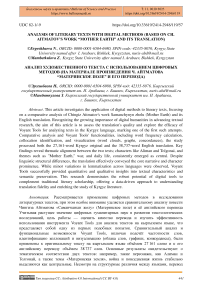Analysis of Literary Texts with Digital Methods (Based on Ch. Aitmatov's Work “Mother Earth” and its Translation)
Автор: Ergeshbaeva N., Mambetkulova Z.
Журнал: Бюллетень науки и практики @bulletennauki
Рубрика: Социальные и гуманитарные науки
Статья в выпуске: 10 т.11, 2025 года.
Бесплатный доступ
This article investigates the application of digital methods to literary texts, focusing on a comparative analysis of Chingiz Aitmatov's work Samanchynyn zholu (Mother Earth) and its English translation. Recognizing the growing importance of digital humanities in advancing textual research, the aim of this article is to assess the translation's quality and explore the efficacy of Voyant Tools for analyzing texts in the Kyrgyz language, marking one of the first such attempts. Comparative analysis and Voyant Tools' functionalities, including word frequency calculation, collocation identification, and visualization (word clouds, graphs, concordances), the study processed both the 27,161-word Kyrgyz original and the 38,737-word English translation. Key findings reveal thematic alignment between the two texts; characters like Aliman and Tolgonai, and themes such as "Mother Earth," war, and daily life, consistently emerged as central. Despite linguistic structural differences, the translation effectively conveyed the core narrative and character prominence. While minor variations in lemmatization across languages were observed, Voyant Tools successfully provided quantitative and qualitative insights into textual characteristics and semantic preservation. This research demonstrates the robust potential of digital tools to complement traditional literary scholarship, offering a data-driven approach to understanding translation fidelity and enriching the study of Kyrgyz literature.
Digital humanities, frequency, word cloud, visualization
Короткий адрес: https://sciup.org/14133974
IDR: 14133974 | УДК: 82-1/-9 | DOI: 10.33619/2414-2948/119/57
Текст научной статьи Analysis of Literary Texts with Digital Methods (Based on Ch. Aitmatov's Work “Mother Earth” and its Translation)
Бюллетень науки и практики / Bulletin of Science and Practice
UDC 82-1/-9
Humanitarian disciplines have made significant progress in solving scientific problems using computer technologies, computerized text research, creating a linguistic corpus, and automating text analysis procedures. Digital humanities are a unique tool for improving the quality of education and helping students grow in many ways. In today’s digital era, it is necessary to move to new educational technologies that help students gain new life and professional skills. That is why students should learn digital methods in the humanities while they are still at university, so they can apply what they learn in their future work at schools. Most digital humanities databases are based on texts. For this reason, text mining and literary text analysis are key research methods. It is important to develop different tools that help with text research. This need has led to the creation of many text analysis tools such as punctuation analysis, tagging, content extraction, reading tools, keyword detection, and more. Literary studies have long been concerned with the examination, understanding, and interpretation of texts. However, over the past few decades, the development of technology has brought about significant changes in this field, with digital methods opening up new possibilities for analyzing literary texts. As a branch of digital humanities, researching literature with digital methods allows for processing large volumes of data (Voyant Tools), discovering new patterns, and identifying connections that might be overlooked with traditional approaches. Voyant Tools was developed by Stefan Sinclair (McGill University) and Geoffrey Rockwell (University of Alberta) .
It is a web-based application that helps researchers and students explore and analyze texts in a visual and interactive way. Voyant Tools makes it possible to find word frequency, key terms, patterns, and relationships in texts quickly and clearly. It is especially useful for studying large amounts of literary texts and discovering ideas and meanings that are not always easy to see by just reading. Therefore, using Voyant Tools can make digital text analysis more accessible and effective in education and research. This article compares the original Kyrgyz version of Ch, Aitmatov's work Samanchynyn Jolu with its translation using the Voyant text analysis tool. The aim of the article is to assess the quality of the translation and to explore the potential of Voyant for analyzing texts in the Kyrgyz language. This research represents one of the first attempts to apply digital methods to Kyrgyz texts and opens new perspectives for the study of Kyrgyz literature. This article represents a pioneering effort in applying digital humanities methods to Kyrgyz literary texts, opening new avenues for academic inquiry into Kyrgyz literature and translation studies. Integrating digital tools like Voyant Tools into literary analysis not only enhances research efficiency but also provides a more data-driven and comprehensive approach to exploring the intricate relationships between original works and their translated counterparts.
One of the earliest digital humanities projects centered on text analysis. When text is available in digital format, it becomes significantly easier to apply text analysis techniques to answer scholarly questions. These methods allow us to examine large volumes of texts, known as corpora, to familiarize ourselves with the information contained within them, and to address specific inquiries. This contrasts with traditional reading, which involves a careful, close study of individual texts we are familiar with. Research Materials: The original Kyrgyz-language full text of Ch. Aitmatov's work [1].
Samanchynyn zholu (Саманчынын жолу) and English translation of Mother earth translated by James Riordan [2].
Chinghiz Aitmatov’s work Samanchynyn jolu expresses the universal human protest against war. The work is narrated through symbolized images of nature and the Earth. The Kyrgyz title Samanchynyn Jolu refers to the constellation of stars in the sky, the Milky Way. However, in Russian (Материнское поле – Mother’s Fieldand in English (Mother Earth), this astronomical term is not rendered literally. These translations represent a particular literary choice that corresponds to the main themes and meanings of the work. The Earth and nature are depicted as symbols of a mother, inseparably linked to human life and destiny. In Aitmatov’s creative vision, the unity of man and nature plays a central role. In most cases, translations aim to convey the symbolic meaning and philosophical context of a work in order to make it accessible to readers of another cultural environment. For this reason, translators often choose titles that are not literal but rather appropriate to the content. The rendering of Samanchynyn Jolu as Материнское поле and “Mother Earth” follows this principle.
Thus, the decision to translate the title in a conceptual and philosophical sense, rather than in a terminological one, altered the original wording. At the same time, it sought to communicate certain aspects of the work more profoundly on the international level.
Research Methods: Comparative Analysis: By comparing the original text with its translation, this method identifies similarities and differences. It helps assess how well the translation conveys the meaning, whether stylistic features are preserved, and reveals any potential losses or changes in the translation. Textual Analysis using Voyant Tools: This method involves both quantitative and qualitative analysis of the texts through the Voyant tool .
It includes the following steps: Uploading the texts into Voyant Tools. Calculating word frequency (identifying the most frequently used words). Identifying collocations (analyzing how words are used in context). Using visualization tools (generating word clouds, graphs, and charts).
As stated in one of the indisputable principles of modern translation theory, no translation can ever be a complete (absolute) replica of the original, because linguistic and cultural barriers lead to the loss of various aspects of the original text's content. In other words, it is impossible to convey information through translation with one hundred percent completeness. This does not mean that translation is entirely impossible; rather, it means that a translation can never be entirely identical to the original [3].
Ch. Aitmatov's work “Mother earth” presents significant challenges in translating Kyrgyz cultural elements into English. Many Kyrgyz works have been translated into English through Russian rather than directly from Kyrgyz. This intermediate step has often resulted in the loss or alteration of original cultural meanings and stylistic features. Many Kyrgyz epithets and cultural symbols (such as "Kut", a sacred symbol of goodness, or "Mother Earth") are difficult to convey in English. Translators have often resorted to simply translating general terms such as "Talaa", which loses their cultural and artistic meaning. Words related to the nomadic lifestyle and traditional Kyrgyz social structure, such as aiyl (a type of nomadic settlement), do not have precise English or Russian equivalents. Translators sometimes use general words such as aiyl, which mislead readers, or resort to transliteration with explanations. The poetic and emotional rhythm of Aitmatov’s prose, deeply rooted in Kyrgyz ethnocultural norms, creates additional difficulties in capturing the spirit and tone of the English text. Translating elements of Kyrgyz culture into English required a balance between literal accuracy and the need to convey cultural depth, which often requires creative or descriptive strategies rather than literal translation.
This article explores Chyngyz Aitmatov’s Mother Earth and its English version translated by James Riordan, using Voyant Tools for comparative analysis. Using tools like Voyant Tools in this article, we can identify the most frequently used words in the original and the translation, create word frequency graphs and compare them, identify key themes and concepts in texts, evaluate the quality of the translation and determine how well the meaning has been preserved.
The original contains 27,161 words, with the most frequent being мен (188), ал (162), Алиман (149), келе (132), Толгонай (86), Эне (80).
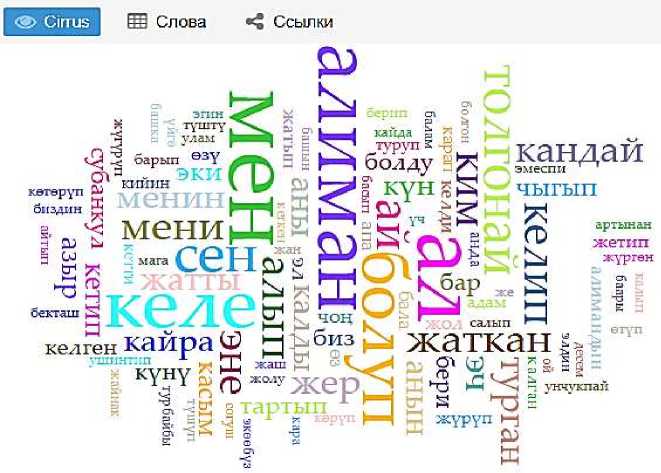
Самые часто встречающиеся слова в корпусе:
• мен (188); ал (182); алиман (149); келе (132); болуп (112); сен (91); толгонай (86); ай (80); келип (75); алып (74); эне (72); ким (71); мени (70); жаткан (69); кандай (64); эч (62); турган (62); жер (61); менин (60); аны (60); жатты (57); анын (57); калды (56); кайра (56); кун (53)
Figure 1. Word Cloud of most frequency words in the Ch.Aitmatov’s work
The dominance of personal pronouns (мен, сен) and main verbs (болуп, жаткан, келет) suggests first-person or conversational content. Words like Алиман and Толгоной likely names or key concepts, point to main characters or recurring themes. The color and spatial distribution help quickly identify which words and topics are most influential or central. This visual overview aids in forming initial hypotheses before deeper manual or computational analysis. Voyant Tools' visualization quickly highlights the structure and thematic density of the text, bringing core content and recurring motifs to the foreground. Such tools empower users to make data-driven inferences about a text’s composition and underlying messages. The English text contains 38,737 words, with the most frequent being: Aliman (199), said (176), Mother (123), time (114), come (103) and names like Kasym, Aliman and Suvankul. These indicate the main subjects and characters of the text. Words like came, began, know, like, saw, left and work suggest actions and events that are key to the narrative or theme. The text seems to revolve around family relationships (mother), important characters (e.g., Kasym, Aliman, Suvankul), and everyday life events such as coming, leaving, beginning, and knowing. Words like time, home, village and night hint at the importance of time and place in the text. In the English translation, names and content words dominate: Aliman tops the list (199), followed by dialogue-related verb said (176), and important thematic words like Mother (123), time (114) and come (103). Aliman is very frequent in both texts, indicating this is the main character. The name Tolgonai (68), which appears frequently in the original, occurs less often or ranks lower in the English frequency list.
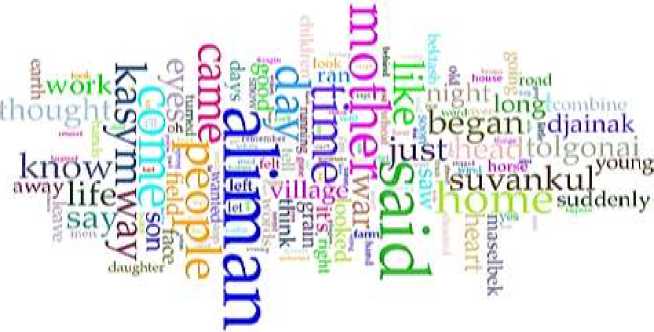
Figure 2. Word Cloud of most frequency words in the Ch.Aitmatov’s work translation
The Kyrgyz text’s most frequent words include many pronouns and function words (мен, ал), reflecting the language's grammatical structure. The English translation’s frequent words focus more on content words related to plot and dialogue (said, mother, time, come). This reflects differing linguistic structures and possibly choices in translation style (more explicit subject use, more reported speech). The word said appearing frequently (176 times) in English suggests many dialogues are explicitly marked, possibly more so than in the Kyrgyz original. The presence of words like time and come indicates narrative action verbs and temporal markers are frequent in English. Text length of English translation is significantly longer. Kyrgyz mostly shows pronouns and particles, while English highlights narrative and dialogue words. This comparison shows typical patterns of translation between the two languages with structural differences and stylistic choices impacting vocabulary frequency and text length.
Both word clouds strikingly align on the central themes and main participants (I/man, mother, said/telling, came/coming) of the text. This strongly suggests that the translation effectively captures the primary content of the original. The English word cloud more clearly highlights proper nouns like Kasym, Suvankul and Tolgoni. While these names would be present in the original Kyrgyz text, their visual prominence might be less due to other highly frequent common words, or perhaps different lemmatization/tokenization behavior for Kyrgyz in Voyant Tools. The English version seems to have consolidated related forms or recognized proper nouns more distinctly. The presence of various forms of a single verb (e.g., келди, келе, келген) in the Kyrgyz cloud, compared to often a single base form (e.g., came) in the English, suggests that Voyant Tools' lemmatization (reducing words to their base form) might be more robust or fully applied for English than for Kyrgyz. Both clouds point to a narrative involving human interaction, time (day, night), and specific settings (home, village, earth, road), indicating a story-like text. both word clouds effectively represent the content of their respective texts. The translation appears to have successfully conveyed the core themes and most frequent terms from the original. Any subtle differences in prominence might be attributed to the linguistic processing capabilities (like lemmatization) of Voyant Tools for different languages.
Terms allows the tool to select and process the most frequently used words in the text and predict the content of the text. For example, by analyzing the list of the most frequent words, we can predict what events are discussed in the work. The next figure illustrates the connections between words — a network visualization of terms that frequently occur near each other in Ch. Aitmatov's work Mother Earth. This visualization helps group words into meaningful phrases and provides insight into the context in which these phrases are used. However, in the Kyrgyz version, the figure reveals only a limited number of such connections.
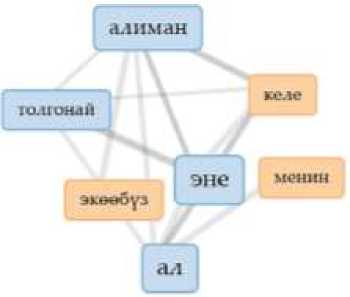
Figure 3. A fragment of the concordance of contexts of the use of the word "Aliman" in the work of Ch. Aitmatov
It is evident that Эне (whether the physical mother, the symbolic Mother Earth, or the concept of motherhood) is the absolute core of this text. Aliman and Tolgonai are crucial characters, deeply intertwined with the Эне concept and with each other. This aligns perfectly with "The Mother Earth," where Tolgonai is the protagonist and Aliman is her daughter-in-law. The frequent use of pronouns like Ал and экөөбүз indicates a narrative style focusing on character relationships and interactions, often seen in Aitmatov's works.
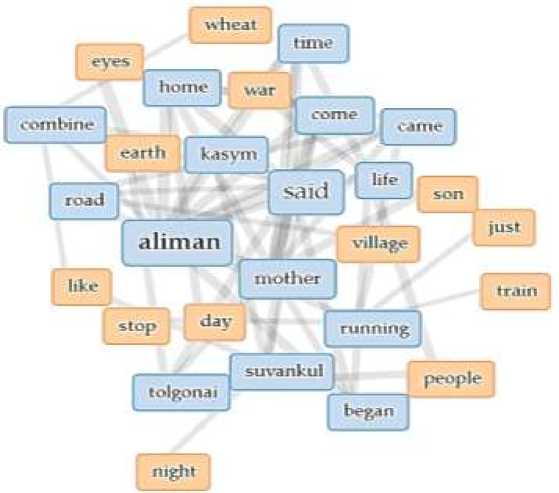
Figure 4. A fragment of the concordance of contexts of the use of the word "Aliman" in the work of Ch. Aitmatov
The presence of verbs like келе (coming) suggests that the text involves specific actions or events, adding a dynamic layer to the narrative centered around these characters. This analysis strongly supports the assumption that the text is from Chyngyz Aitmatov's "The Mother Earth," as the relationships between Mother, Tolgonai and Aliman are central to that novel's plot and themes.
The word Aliman appears to be a central node because it is connected to many other words. Other important nodes are: said, Tolgonai, war, earth, village. The following themes can be observed in this visualization: words like war, life, people, village show the impact of war on people's lives. Words like Аliman, Тolgonai, Subankul, mother, son reflect family relationships and the connection between the characters. Words like earth, wheat, forest show the importance of farming and labor. Strongly connected to time, home and combine. This is a crucial thematic element in "The Mother Earth" describing the impact of World war II on the characters and their lives. Home is connected to Aliman, mother, war, earth, road and Tolgonai. Emphasizes the significance of the home as a setting and concept. Earth is connected to Aliman, home, road. Reinforces the theme of the land and its connection to the characters. Temporal words time, day, night are scattered but connected to various characters and actions, emphasizing the passage of time and daily life (and its disruption by war). Life is connected to Aliman, Tolgonai and began. A central theme. Wheat is connected to combine and time. Directly related to the agricultural setting and the harvest.
This English network graph strongly reinforces the conclusions drawn from the previous Kyrgyz graph and the English word cloud, specifically: Aliman, Mother, Tolgonai and Suvankul are clearly the most significant entities, with Mother and Aliman having the highest number of strong connections. The prominence of said indicates that a large part of the narrative is conveyed through speech or reported speech. The strong connections around war, home, earth, combine, life, wheat and temporal words (time, day, night ) perfectly align with the core themes and setting of Chyngyz Aitmatov's "The Mother Earth," which recounts the story of Tolgonai during World War II, her family, and their struggle with the land and the combine harvester. The graph suggests a narrative that focuses on characters' relationships, their daily lives (agriculture, home), and the profound impact of historical events (war) on their existence .
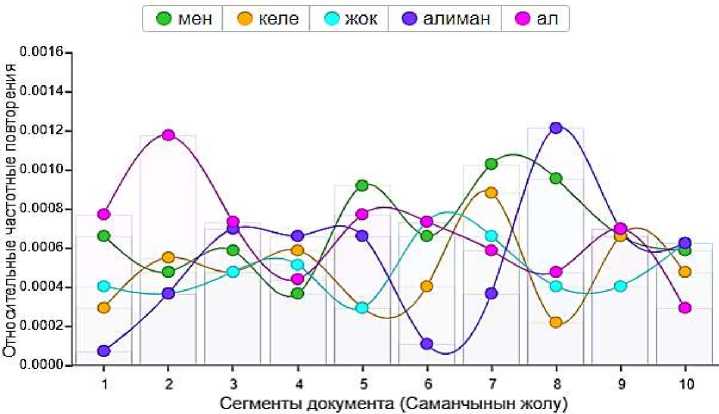
Figure 5. View of the Trends in the original text
The general trends in word usage in the English and Kyrgyz versions are similar: the name of the main character (Aliman/Алиман) reaches a peak in each text, which may indicate important changes in that part of the plot. Also, the English text is more descriptive and action-expressing
Т. 11. №10 2025
(said, come), while the Kyrgyz version is dominated by personal names and short words (мен, ал, жок). This is explained by the specificity of the translation and the natural word choice in the Kyrgyz language.
The relative dynamics of words differ slightly in the two languages - in the English version, some words have sharper peaks, while in the Kyrgyz version, the differences between sections are relatively less.
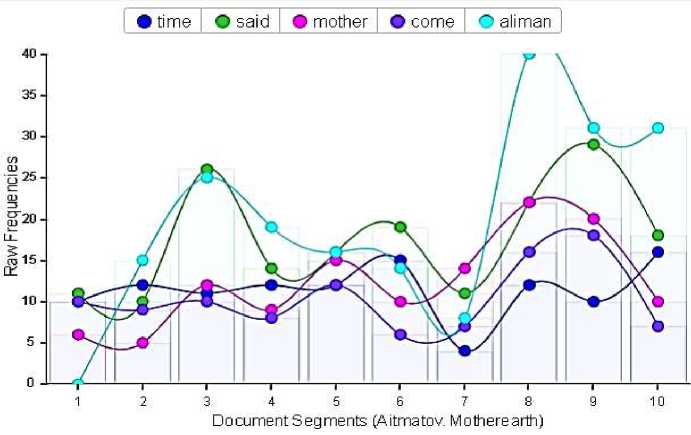
Figure 6. View of the Trends in the target text
You have seen that the verb said is the most frequently used word in the work if we compared to other words found in the work, it has a constant use in all lines. As can be seen from the graph, this type of analysis consists of dividing the text into 10 equal parts and finding the number of occurrences of the most frequently used words in the text (in this case, time, said, mother, come, Aliman).
1 i Contexts
£1
Ducurnort
Al twain*' Mirer
Aitmatov Mod**
Aitmatov Mirer
Aitmatov Moder
Я Aitmatov Storer
0 Aitmatov Matter
Я Aifmnhw mt*■<
fl Aitmatov M.tm
Aitmatov Mww
В
Aitmatov Мапм

Term
What sncMJ wo da abort oilman
Hirryl'Агк] *r*vry:.i'»’rat| .^-» зЧтап
Shell be ow coon " Ater ahman
lied dbodt lire* ^че» dt*»
tit me tor long afterwards aiman
■^ .»je#>
were Огяегчз Now once again allman
tdha lint rwi Ite Al’ oilmen her own I Co Ah, Al rrjr oilman
I begun calkng hr** ‘^imanl *iman began to gasp г»х>-м^ 'AJimani oilman
Right
г Да sha a res Md her bst la
^.ч1 RxtMl G« forw I
left thodj(t droojodon
i mourned my ем» *>end
came turning towards me, wars
teoon going off rt the
A>nanl it you wt* het»
I r you Tero twee «tri г Bui ah* did m*er»yw
I iMiatx re matter?* I wid
D
Aitmatov M T«
Aitmatov Mirer
herowi*deas Oh Alnw oilman
В
Ailment* м tm
Aitmatov More*
3 Mmeiov Mow* fl Aitmoinv MoTer
3 АШПМОУ МЛэч fl Aitmatov Morsr
AitmMOV Mom
0 Aitmmcv Mover fl Aitmafow Mtw
0 Aitmatov Moter
her and began reading amici
ogerito team me atohooetl* oilman
av*^^ held ijimi»’- Wck And ahmen
Storanfal. Kasym, Masatbah.Dianflli and oilman
IhM
hi
h the spmg ha and unman
me be мМтеаЛ Kee^m and ehman
re пм offerrooe Kasym and ohman
W»ai I 90** I itoytr *«• J
here and there Kasym and oilman
лгу «tew Iwtotedd 4wj4win
my SMoetdeuartor-in-ieM
meenwriie. зддою down and began
began pummetro him. men trey
hW6u< nm*v Tented tn Htwi
tidy had no rest d^t
ml m< up house tor l»ea«>«J tew* da th* road, tewing
cvenooh the c 1 . ■ • had also roedvod a plot Figure 7. A fragment of the concordance of contexts of the use of the word "Aliman" in the work of Ch. Aitmatov (jw* пжа» сйш азида мах «рц>л1)п кштмем тршуид ггг дет» имижэвем г»фме^«^««e*jtf i*W4* Х^^да^м^;. н^»и^ га» дадо*««р ^жадафбсгдшшЭД И^Ф*«аэт<&лн«* ДО'АЧК'ЭДО>Лг .гы»- асэр да, опаде ветер» жди путдироя Ту^г жом TouF 1 ри уступ мк» мяэ» Путер ж»де иж» <прз ль «дедарж грет "Л агдае сала руга тв dam гкмткутда says ле «ре донн mat а &MBR м»ждоКгаы«ДО)ДО4 <|ММ1р пжтоал»да иен пандам вд этиашр до to га» ^-^уг^рде*^ М«дониш долдон»тудоР'иамыеждоде«ужууДОлтдом* Сам» tow лтт^идиыим до» Чш» ‘>«Г дач гну «амдо ^пд» мм.аи ссомиан*»'идеп мвп агж» (**>•»«<'V**au*i»i,uW0Y гяптечГйда1ТшоД«1беэв*Ще'чмбоделрхггуи*у КаЛмдеш» Садам рм£<шдох?тдп/tatedKMixBMt?пэофй^Мдмтф туи-туи отх»<з^йЖ> Фи»XVW* tfw» сМдаде*«эдмтуту*яп«рууда| Т>А тугда ооо1«всдаК1ДОйиь»,з«*въ1а><1М1 иакл* шт» d'-gnet СМЯ* МО л» &V ДО^ЬИ ф& УДО QaiaoHFж индо ДОМ, to* *Wt ОДО ЭДОт ОЙ ММ га» to SMmfs иДО ДО WW ДО ПНКЛЙ «МП< ДО М ДО ^iwi 'КДОТ ХМ (вЫЖГе _зи»- дот адо«*£ь-т даэммв^ даа₽вжм«гр«а€«а нём Ч?«адо**»п Ияяути дог да идаям Кмж<>егфр^ i'Jwsjzx^ to» Лгтои»еп»лтш*»ш яттв w* cu,ui*ncat« uaxw? < ДО ДО *1н» ДО1ДО п ДОуЖЙМД ДОШ«М»Ш# Ммип ДОФ М Атм Дол i>Hf! too яти» Ш*Т1»<ЛЙНи I» «M*ipO*Al»n^T» ШЧАДО води Мжц» un4UW TM»«C*|f)K Сам» erp Ml амидо» да «мм op eeip» M<«b»je',w«MTpi Иесиспр га» ur«i.ufMia*riiuifi М|«ууугй1(М1М№тааапьда Седоимде-ммН Свй^льДОыиамГц <лы»» втд| Агкдапз «ро вгтем мет Амон мы клят стр тит ■WPP Й** мяНмамда да ТМц ®ЖМ № туру шра самыа» апл кт чоисрпйа<>ЧГУ1вДО ледаяе Аяш»иет<ягт«тго|«эам \ -зн» toot тум#|да*ицгы^*< мнутунуисти^згпп*»1 laiMM too» usiaacaeat ®teq ган< осатеа$*л манча къпп тгкйТкиtoreат?«»одет. '^ия» ЭлвстанГ СЛлм vmim дои» мДОш» яги №« и-m шип**# Кга НЯс1Гм1 га» уамтр ДОМ*НИ1 мтиргнт япмл-идоыкдем до mi Kra долг саунам» м» 5 Figure 8. A fragment of the concordance of contexts of the use of the word "Aliman" in the work of Ch. Aitmatov Relative frequency is divided into ten parts, indicating the frequency and percentage of terms in the document. For example, the word "Aliman" has a relative frequency of 0.0010326, which is about 10% of the document. Context helps to determine the usage of the most common key words used in the tool and shows the text that appears to the left and right of the word in the text. The visualization that includes all events related to Aliman in context. The Kyrgyz contexts generally appear to provide longer, more complete snippets of the original text, as they are in the source language. This allows for a deeper understanding of the nuances in the original phrasing. The English contexts offer direct translations, which may sometimes be slightly more concise or focus on the immediate words around Aliman. The highlighting of Aliman in the Term column is consistent in both. These two images are highly valuable demonstrations of Voyant Tools' contextual analysis capabilities. They clearly illustrate the significance of the word Aliman in Chingiz Aitmatov's "The Mother Earth" and how she is referenced in various contexts, including character descriptions, family relationships, actions, and dialogue. The Kyrgyz image provides the authentic, original phrasing, while the English image offers the translated counterpart. By comparing them, one can not only understand Aliman's role but also observe how linguistic nuances are handled in the translation, providing insights into both the original text and its rendition in another language. It can be very useful to use tools such as Voyant Tools to analyze how the frequency of words in the original text affects the meaning of the translation. These tools allow you to compare the frequency of words in two texts (original and translated). As a result of the comparison, you can determine how the overall meaning has been affected. The frequency of words in the original text affects the meaning. If certain words or phrases are used frequently in the original text, they may indicate the main themes or concepts of the text. The frequency of words can help determine the style and characteristics of the author's writing. For example, the frequent use of a particular word may indicate the author's point of view or emphasis. The frequency of certain words can indicate the emotional tone of the text. For example, a large number of words with a negative connotation may indicate that the text is sad or critical. If the frequency of words in the translation matches the original, then the translation is considered to have conveyed the meaning correctly. If the frequencies differ significantly, then the meaning in the translation may be distorted. The frequency of words in the translation should correspond to the grammatical and stylistic features of the target language. For example, in Kyrgyz, some words may be used more often than in other languages. The frequency of words in the translation affects how readers perceive the text. If the translation contains many unfamiliar or rarely used words, it may become difficult to understand the text. Voyant Tools offers a powerful, accessible platform for applying digital textual analysis to literary works such as Mother Earth. By combining frequency analysis, concordances, collocations, and visualization, scholars can uncover patterns that enrich understanding of themes, character prominence, and narrative structure. This complements traditional literary scholarship and opens new avenues for comparative and translation studies. This study demonstrates the immense potential of digital methods, particularly using Voyant Tools for the in-depth analysis of literary texts and their translations. By comparing Chingiz Aitmatov's original Kyrgyz novella, Samanchynyn Jolu, with its English translation, we successfully assessed translation quality and explored Voyant's capabilities for analyzing texts in the Kyrgyz language. The analysis revealed that despite linguistic structural differences, the translation effectively conveyed the core themes and character prominence of the original, as evidenced by the similarities in word clouds and thematic networks. The dominance of key characters like Aliman, Tolgonai, and the recurring theme of "Mother Earth" was consistently highlighted across both versions, affirming the translation's success in capturing the narrative essence. This was clearly evidenced by the striking similarities in word clouds and thematic networks across both versions. The consistent prominence of key characters like Aliman and Tolgonai, along with the recurring theme of "Mother Earth," affirmed the translation's success in capturing the narrative's essence. While Voyant Tools proved effective in identifying word frequencies, collocations, and thematic clusters, the study also underscored some nuances, such as differences in lemmatization robustness for Kyrgyz versus English, which can influence visual prominence of words. Nevertheless, the ability to generate word frequency graphs, word clouds, and concordances provided invaluable quantitative and qualitative insights into the textual characteristics and the preservation of meaning across languages. The analysis of word trends further illustrated how central elements of the plot, such as the peak appearance of the main character's name, are reflected similarly in both original and translated texts. This research represents a pioneering effort in applying digital humanities methods to Kyrgyz literary texts, opening new perspectives for academic inquiry into Kyrgyz literature and translation studies. Voyant Tools offers an accessible and powerful platform that complements traditional literary scholarship by enabling scholars to uncover patterns, assess translation fidelity, and enrich understanding of complex textual layers. The findings strongly suggest that integrating such digital tools into literary analysis not only enhances research efficiency but also provides a more data-driven and comprehensive approach to exploring the intricate relationships between original works and their translated counterparts.

